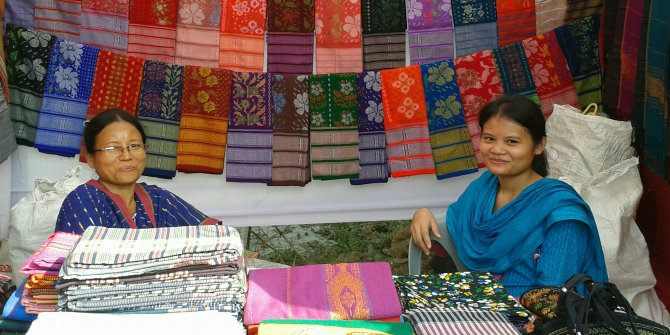In this interview with Anna D’Alton (LSE Review of Books), Naila Kabeer discusses her new book, Renegotiating Patriarchy: Gender, Agency and the Bangladesh Paradox, forthcoming from LSE Press in September. The book examines positive social change in Bangladesh over the past 50 years, in particular the factors that enabled significant and rapid gains for women in areas like health, education and employment within a deeply patriarchal society.
Naila Kabeer joined Monica Ali, Phillip Hensher and Sarah Worthington on Saturday 15 June for an LSE Festival event, Power and Storytelling. Watch it back on YouTube.
Renegotiating Patriarchy: Gender, Agency and the Bangladesh Paradox. Naila Kabeer. LSE Press. 2024.
 What is the “Bangladesh paradox”?
What is the “Bangladesh paradox”?
Bangladesh has been described as a new nation but an ancient land. For much of its history, Bangladesh was colonised by foreign powers, first by Hindu and Buddhist rulers from other parts of India, then by the Moghuls, followed by the British. When the British left in 1947, what is now Bangladesh was incorporated into Pakistan but occupied the status of a quasi-colony. It fought a war of liberation before finally becoming independent in 1971.
The long history of colonial extraction meant that Bangladesh embarked on independence as one of the poorest countries in the world. It had extremely high fertility rates which made it one of the most densely populated countries in the world. It had a largely illiterate population that eked out a living in subsistence agriculture. It also had a very patriarchal culture, one it shared with the northern plains of India, that gave rise to very strong son preference and a tradition of discrimination against daughters. The high fertility rates in the country were partly due to the pressure on women to have enough children to ensure a minimum number of sons, pressure which resulted in very high rates of maternal mortality. Bangladeshi women were described by a Population Crisis Committee report from the 1980s as “poor, powerless and pregnant”, with the lowest status among women from the 99 countries covered by the report.
Bangladesh was regarded by the donor community at the time [of independence in 1971] as an “international basket case”[…] Yet by the 1980s, fertility rates began declining at a speed that set a record in demographic history.
Bangladesh was regarded by the donor community at the time as an “international basket case”, a country would need foreign aid into the foreseeable future if it was to survive, let alone thrive. Yet by the 1980s, fertility rates began declining at a speed that set a record in demographic history, there were striking improvements in health and nutrition and educational levels began to rise. What stood out about these changes is the disproportionate gains made by women and the resulting decline in gender inequality. So the term “Bangladesh paradox” is used as shorthand to describe the remarkable progress that the country made in spite of high levels of poverty and poor levels of governance.
There is one other element to the paradox that is less widely remarked on that interests me. The improvements observed in gender equality came at a time when the country had begun experiencing a steady rise in a very orthodox version of Islam, one imported from the Middle East and antithetical to many of the gains women had made.
Q: What aspects of the Bangladesh paradox does your book, Renegotiating Patriarchy address?
There have been many explanations of the Bangladesh paradox, but they tend to focus on the role of powerful actors such as the state, the donors and the non-governmental sector. They all have a part to play, but at the heart of the story I tell in this book is what I believe to be the main driving force behind the changes we associate with the paradox: the ideas, values and motivations of ordinary people. This hidden story of change takes as its starting point the evidence emerging in the literature that there had been a significant decline in son preference and a move towards more egalitarian preferences, with many parents satisfied with only having daughters. This was in sharp contrast to India where parents were seeking to reconcile their desire for fewer children with the practice of female-selective abortion to ensure that their children were only, or mainly sons.
At the heart of the story I tell in this book is what I believe to be the main driving force behind the changes we associate with the paradox: the ideas, values and motivations of ordinary people.
Clearly there had been some kind of shift in the structures of patriarchy in Bangladesh: girls were now more likely to survive the early years of life than boys (the norm in much of the world); they were more likely to be enrolled in primary and secondary school than boys and their labour force participation rates had been rising consistently, overtaking those of India and Pakistan.
My book sets out to find out what led ordinary people make the changes in their lives which coalesced into the Bangladesh paradox. And because there was evidence accumulating in various studies that women had played an important role in making these changes happen, I was particularly interested in this aspect of the story. Given Bangladesh’s patriarchal traditions, I wanted to know what motivated women to seek change and how they were able to bring it about when the changes they sought seemed to go against the grain of these traditions.
Q: What was your methodological approach and how did you arrive at it?
The book is interdisciplinary in its approach and pluralist in its methodology. As I noted earlier, there have been many “big picture” stories about the Bangladesh paradox. What has been missing are the multitude of “small picture” stories from ordinary men and women. A great deal of the book is made up of these stories, gathered from my own research and from research that others have carried out. By examining the experiences and motivations related by different generations of women and men over successive periods of time, I was able to trace the unfolding of the Bangladesh paradox through the shifts in attitudes that they reported, the actions they took in response to survival imperatives and the changes in their aspirations as new possibilities came into view.
These narratives form the core of my analysis, but I draw on a range of other sources of information as well. I go back into the history of Bangladesh to understand the more tolerant version of Islam that had flourished in the country, an amalgam of the various religions that had co-existed in the region and that may have been a factor in allowing women to make the gains they did. I draw on secondary literature to understand the evolution of the country’s policy and legal architecture, piecing together the story of the economic changes that allowed the country to transcend its past poverty. These constitute the structural context within which individuals and groups were able to exercise certain forms of agency but not others, which allowed women to “renegotiate” the more oppressive aspects of patriarchy rather than to overthrow it.
Individuals and groups were able to exercise certain forms of agency but not others, which allowed women to ‘renegotiate’ the more oppressive aspects of patriarchy rather than to overthrow it.
In addition, woven into my account of the qualitative explanations that men and women gave for their behaviour are statistical findings that helped me to distinguish between the explanations that embodied the experiences of the few, perhaps those who were ahead of their time or lagging behind, and those of the many whose experiences were widespread enough to shape the larger statistical trends.
Q: A central research question in the book is around the decline for son preference among families and communities in Bangladesh. What were the reasons for son preference?
Bangladesh is a part of a larger region that Deniz Kandiyoti refers to as “the belt of classic patriarchy” stretching from North Africa across the Middle east and the northern plains of the South Asian sub-continent, including Bangladesh. These countries may have very different histories, different religions, different economic trajectories, but they share certain features of their gender and kinship relations in common. They are characterised by patrilineal descent so that the family name and property pass through the male line. There are strict restrictions on women’s mobility outside the home so they are confined to reproductive and home-based activities, dependent on male breadwinners for most of their lives. Daughters are married off early and leave the parental home to be absorbed into their husband’s lineage. Sons, on the other hand, carry on the family line, inherit its property, engage in productive work and look after their parents as they get older. Not surprisingly, these societies are characterised by a strong preference for sons, with lower levels of female education and labour force relative to male and, in contrast to the rest of the world, higher levels of female mortality, particularly in the younger age groups.

Q: In your research, you discovered that there was a decline in son preference in the past forty or fifty years. What were some of the reasons for that decline?
My interest in son preference goes back to 1980 when I was doing my PhD at LSE and researching the reasons for high fertility in Bangladesh. I spent a year doing field work in a village in Bangladesh where it became clear to me that women had a particularly strong preference for sons over daughters, both to assure their status in their husband’s family and because sons represented security in old age. After my PhD, I joined the Institute of Development Studies, Sussex and continued to do research in South Asia. I was aware of the various studies from Bangladesh documenting, among other things, increasing gender equality in survival rates, health, nutrition and education. To find out why this was happening, I went back to the village in which I had conducted my PhD field work.
My interest in son preference goes back to 1980 when I was doing my PhD at LSE and researching the reasons for high fertility in Bangladesh.
What I found makes up the concluding sections of the book where I also touch on why a similar shift in son preference had not been happening in India. The full answer on the reasons for this shift, detailed in the book, are complicated and tangled up with the overall story of the Bangladesh paradox. The short answer revolves around changing intergenerational relationships and the belief on the part of parents that sons had become more focused on their own wives and children to the neglect of their parents, that daughters-in-law were not as subservient as they used to be and that daughters are now not only regarded as more loyal to their parents than sons. They are perceived as being more concerned about their welfare, but also, with the rise in their income-earning opportunities, in a better position to help them materially. It was mothers who were often at the forefront of this revaluation of daughters.
Q: You deal with the rise in women’s labour force participation in your book. What was its significance?
It has been very significant. There is an interesting contrast here between Bangladesh and India. India has one of the highest per capita growth rates in the world but its female labour force participation has been declining steadily and is now among the lowest in South Asia. In fact, the jobless nature of India’s growth has seen high levels of unemployment among men as well. Although Bangladesh’s growth rates are also high, it remains far poorer than India. However, it has had a more labour-intensive pattern of growth and generated opportunities that have benefited women as well as men. Its microfinance programmes have allowed women to take up income-generating activities that could be carried out within or near the home. Its export-oriented garment sector had a largely female labour force. Community-based services, including those provided by NGOs, hire large numbers of women. In Bangladesh, women’s ability to make a direct contribution to household income has been an important factor in enhancing their voice and agency within their households, has made daughters appear less of a burden to their families and has given women the motivation to resist the efforts of Islamist forces to curtail their opportunities.
Women’s ability to make a direct contribution to household income has been an important factor in enhancing their voice and agency within their households
Q: Do you think that the positive social changes, including the progress on gender equality that the paradox describes will be sustained in the future?
It’s hard to say. I feel somewhat pessimistic but not just in relation to Bangladesh. The whole world seems to have become darker – it is more unequal, there are more wars, more natural disasters, more financial crises and, of course, accelerating climate change. And the same market fundamentalism that impededes our ability to put things to right in the rest of the world is also holding it up in Bangladesh.
We have seen inequality rising in Bangladesh over the last decades. Whereas in the early years after independence, it was possible to make important gains on the health front with low-cost vertical programmes, we now need broad-based health services so that everyone can be assured of decent care when they need it. Quantity in educational provision has been achieved at the expense of quality, and quality has been undermined by compromising on a secular curriculum in deference to Islamist forces. We have had multiparty democracy since 1990 and mainly civilian rule, but when the same party has been in power since 2009, we know it is not a very healthy democracy. Meanwhile, the rise of an intolerant Islamic orthodoxy has continued and may have been given fresh oxygen by what is happening to Palestinian people in Gaza today. I am not sure whether the pace of social progress we saw in the past will be sustained in the future. But who knows? Bangladesh has defied the odds before; it may do so again.
Note: This interview gives the views of the author, and not the position of the LSE Review of Books blog, nor of the London School of Economics and Political Science.
Main image credit: A woman in Subarnachar, Noakhali, Bangladesh. Photo © Jannatul Mawa.








